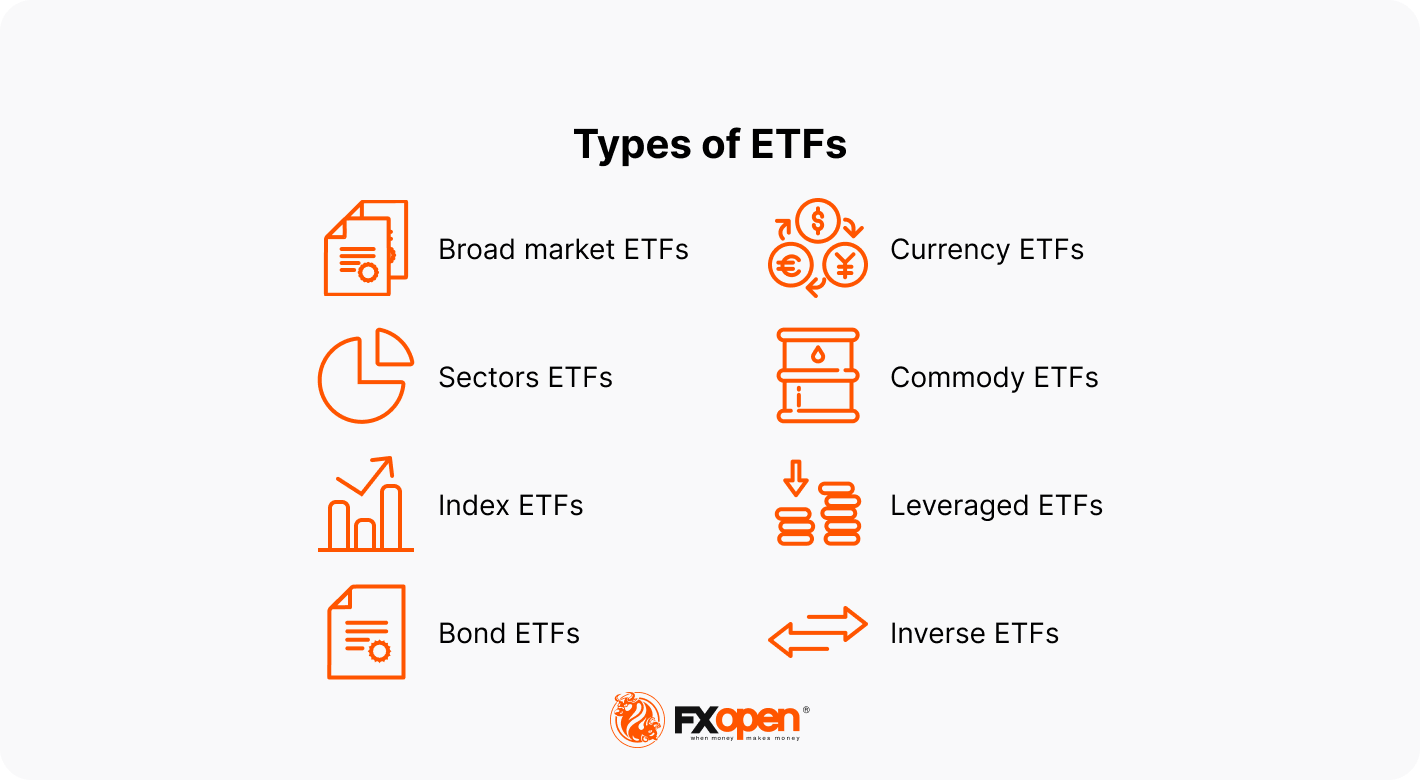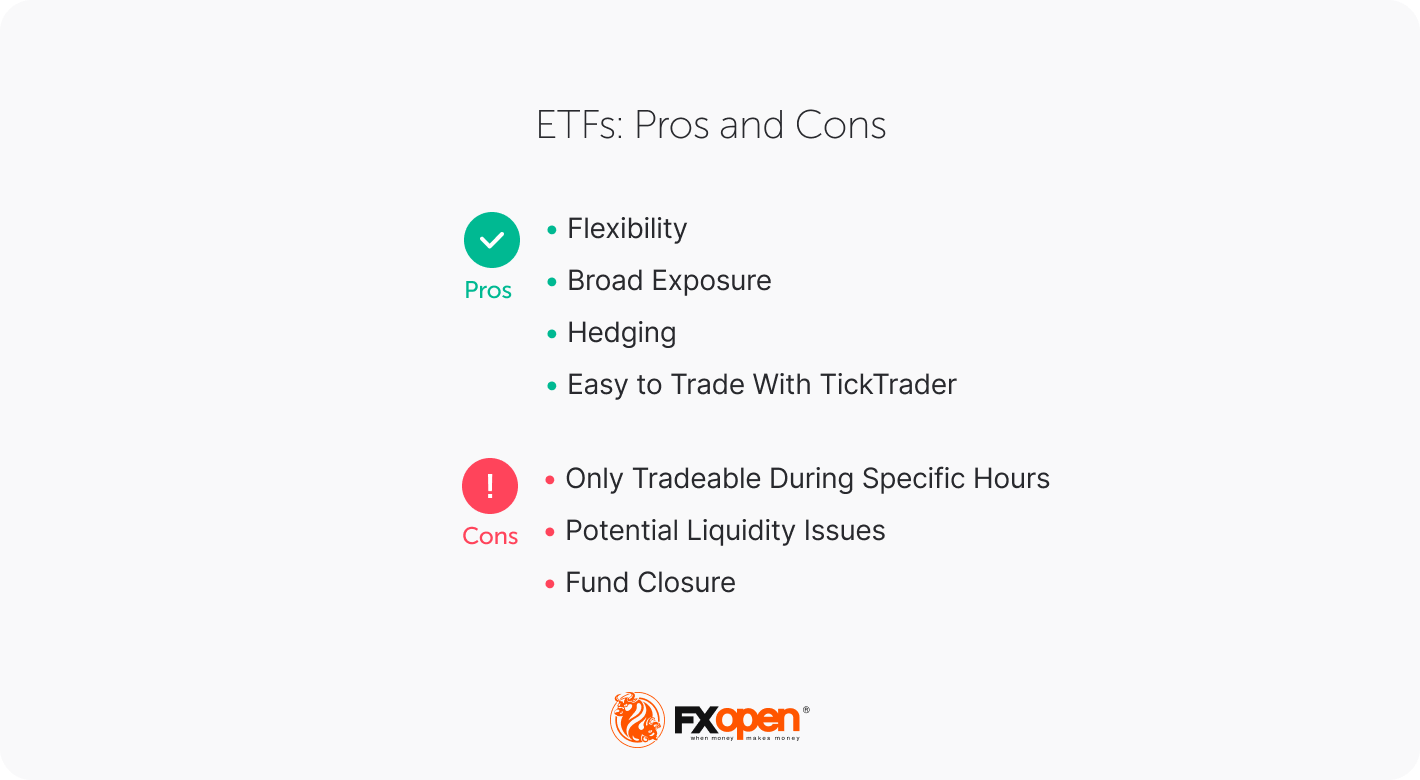FXOpen

Exchange-traded funds, or ETFs, have gained significant popularity in recent years as a way to inves tin a diversified portfolio of securities. But for the uninitiated, the world of ETFs can seem complex and overwhelming. So, what is an exchange-traded fund, and how does it work? In this article, we’ll cover everything you need to know about ETFs, the advantages and disadvantages, and we’ll explain how to trade ETF CFDs.
What Is an ETF and How Does It Work?
The ETF definition in investments is the following: exchange-traded funds (ETFs), sometimes called equity-traded funds, are financial products that track the performance of a specific index, commodity, or group of assets. ETFs are popular among individual and institutional investors thanks to their flexibility, low fees, and transparency.
Like stocks, ETFs are traded on exchanges. This means that you can buy ETF shares when the stock market is open. Note that you buy shares of a fund, not the fund itself. Unlike stocks, however, ETFs don’t focus on a single asset. Instead, ETFs consist of multiple assets and even different asset classes, such as stocks, bonds, commodities, and cash. Some ETFs are passively managed, meaning they’re designed to track a specific market or sector. Others are actively managed and have professional portfolio managers who choose which assets to include in the ETF.
ETFs are an effective way for traders and investors to diversify their positions. Because ETFs comprise a diverse range of securities, holders can gain exposure to different assets, markets, and sectors without having to trade each one individually. This can help reduce risk and volatility and potentially generate more stable returns over the long term.
Differences and Pros and Cons of ETFs vs Mutual Funds
While they share some similarities to mutual funds, one of the main differences between the two is that mutual funds are only traded at the end of the trading day according to their net asset value (NAV), while an ETF’s share price fluctuates throughout the day.
Mutual funds pool money from investors to invest in a range of assets and are often actively managed by a professional portfolio manager. This means they typically come with higher fees and a higher minimum investment requirement.
Generally speaking, ETFs are the more cost-effective and flexible option, as they offer lower expense ratios and allow for intraday trading. They also tend to be more tax efficient due to their reduced portfolio turnover rates. However, ETFs come with commissions, while mutual funds do not. Moreover, the passive management style of many ETFs can lead to lower returns compared to mutual funds, which aim to beat the market through active management.
ETF Types
There are many different types of ETFs out there that can be used to meet a wide variety of investment goals. Let’s look at some examples of exchange-traded funds.

Index ETFs
What is an ETF in the stock market? Equity ETFs are those that track a stock index. They vary in terms of the sectors, industries, company sizes, and countries they cover. Equity ETFs are divided into broad market and sector ETFs.
Broad Market ETFs
These ETFs track the performance of the entire market. They can be a useful tool for investors looking to gain exposure to the overall market without having to pick an individual instrument. One of the most significant broad-market ETFs is the SPDR S&P 500 ETF.
Sector ETFs
Sector ETFs offer investment in specific industries or areas of the market, like technology, healthcare, energy, and financials. These ETFs are ideal for investors looking to profit from the overall growth of an industry. Popular sector ETFs include the ARK Innovation ETF.
Bond ETFs
These ETFs invest in fixed-income securities such as government, corporate, and municipal bonds. Bond ETFs expose investors to the fixed-income market, which can be an effective tool for diversifying a portfolio. One of the bond ETFs is iShares 20+ Year Treasury Bond ETF.
Commodity ETFs
Commodity ETFs invest in assets like gold, silver, oil, and other natural resources. Commodity ETFs offer investors easy access to the commodity market and can help them hedge during market downturns. SPDR S&P Oil & Gas Exploration & Production ETF (XOP) is an example of a commodity ETF.
Currency ETFs
These ETFs invest in foreign currencies and are used to gain exposure to a particular country’s currency or group of currencies, meaning they can be used to hedge against currency risk. Primary currency ETFs include the Invesco DB US Dollar Index Bullish Fund.
Leveraged ETFs
Leveraged ETFs use derivatives to provide investors with magnified exposure to the underlying assets, typically 2x, 3x, or 5x. For instance, a 2x leveraged ETF based on the S&P 500 would drop 2% if the S&P 500 fell by 1%. Direxion Daily Semiconductor Bull 3X Shares ETF is one of the most popular leveraged ETFs.
Inverse ETFs
These ETFs allow buyers to invest in the inverse performance of the underlying asset. For example, an inverse ETF that tracks the S&P 500 would go up when the S&P 500 goes down. Inverse ETFs can be useful for hedging against market downturns but also shouldn’t be held long-term. An example of an inverse ETF is the ProShares Short S&P 500 ETF.
How to Trade ETF CFDs
Aside from buying ETFs on stock exchanges, you can trade them via CFDs. CFDs are derivative products that allow traders to speculate on the price movement of an underlying asset, such as an ETF. Unlike traditional ETF investing, ETF CFD trading does not involve owning the ETF itself. Instead, traders are exposed to the price movements of the underlying ETF when they open a position.
At FXOpen, we have dozens of ETF contracts for difference (CFDs) that are ideal for short-term trading.
One key benefit of CFD trading is the use of leverage, which allows traders to open larger positions with smaller amounts of capital. This can potentially amplify profits but also magnify losses. All of our ETF CFDs offer 1:5 leverage, so to open a $100 position, you’ll need $20 to cover the margin requirements.
Moreover, ETF CFDs can be opened long or short, allowing traders to profit from both rising and falling markets. This can be especially useful when looking to hedge against an existing position or take advantage of short-term market movements.
Unlike regular ETFs, CFDs are subject to overnight fees, which are charged for holding open positions overnight. However, the same as with regular ETFs, CFD traders receive dividends if applied. The dividend adjustment is positive for buy trades and negative for sell trades.
Consider a Trading Strategy
If you’re thinking of trading ETF CFDs, it’s important to have a trading strategy in place. One approach is a trend-following strategy, which involves identifying and entering in the direction of the trend of the underlying ETF. Many traders use technical analysis tools, like moving averages and trendlines, to help them gauge the direction of a trend.
Seasonal trend trading can also work particularly well for ETF CFDs. Traders using this strategy look at historical market data and identify trends that tend to occur during certain times of the year. For example, a retail sector-based ETF might perform well around the holiday season, so traders could use this expectation to guide the direction of their trade.
Some traders prefer breakout trading - taking positions in ETF CFDs when their prices break through key support or resistance levels. Breakout trading can be especially effective in ETF CFD trading because ETFs tend to be less volatile than individual stocks. This means that when an ETF breaks through a support or resistance level, it may continue in that direction for an extended period, providing traders with an opportunity to profit.
Trading ETF CFDs: Advantages and Disadvantages
While we’ve explained some of the key advantages and disadvantages of ETF CFD trading, there are other factors to consider. Here are some additional advantages and disadvantages of ETF CFDs to be aware of.
Advantages
Flexibility: ETF CFDs can be bought and sold quickly throughout the day, providing traders with the flexibility to adjust their positions in response to intraday market events.
Broad Exposure: ETF CFDs offer exposure to a wide range of global markets and sectors, meaning that traders can diversify their positions and speculate on the price movements of a market or sector as a whole rather than relying on a single asset.
Hedging: This broad exposure also allows traders to use ETF CFDs to hedge against their other positions and reduce their potential losses. For example, a trader long on tech stocks could use a technology-based ETF CFD to short the sector during earnings season to protect from downside risk.
Easy to Trade With TickTrader: Our native TickTrader platform makes ETF CFD trading a breeze with built-in charts, analytical tools, and an easy-to-use interface.
Disadvantages
Only Tradeable During Specific Hours: ETF CFDs are only available to trade when their respective exchanges are open. This might only be 9:30 a.m. to 4:30 p.m. EST, whereas other types of CFDs, like forex CFDs, are available to trade 24/5.
Potential Liquidity Issues: During periods of high volatility or low volume trading hours, some ETF CFDs can suffer from poor liquidity. This can widen spreads, increase costs for traders, and heighten the risk of slippage.
Fund Closure: While rare, it is possible for an ETF to cease trading while you have an open CFD position. This would result in the liquidation of the position and the net profit or losses being realised. When combined with leverage, a forced liquidation could lead to significant losses.

Your Next Steps
Now that you have a solid understanding of ETFs and their CFD counterparts, you may wonder how to start trading them. Follow this step-by-step guide to get started:
1.Open an FXOpen Account: At FXOpen, we offer a wide range of ETF contracts for difference (CFDs) that you can begin trading in minutes.
2.Explore ETFs: The next step is to look for ETFs that align with your strategy. You can research factors like potential for growth and historical performance to help determine if an ETF is right for you. You may also want to consider elements like the ETF’s level of diversification and trading volume.
3.Place a Trade: Once you think you’ve found the ETF you want to trade, you can use the TickTrader terminal to enter a position. This involves selecting the ETF CFD you want to trade, choosing the appropriate trade size, and setting stop losses to manage risk. At this stage, you could also set some targets for where you’d like to exit your trade.
4.Manage Risk: As your trade progresses, the only thing left to do is manage your position’s risk. You could do this by gradually moving your stop loss closer to breakeven, taking partial profits, and hedging your position with other ETF CFDs.
This article represents the opinion of the Companies operating under the FXOpen brand only. It is not to be construed as an offer, solicitation, or recommendation with respect to products and services provided by the Companies operating under the FXOpen brand, nor is it to be considered financial advice.
Stay ahead of the market!
Subscribe now to our mailing list and receive the latest market news and insights delivered directly to your inbox.








